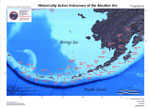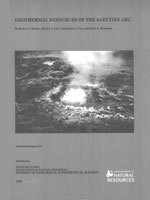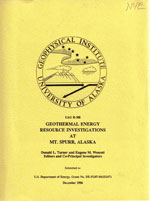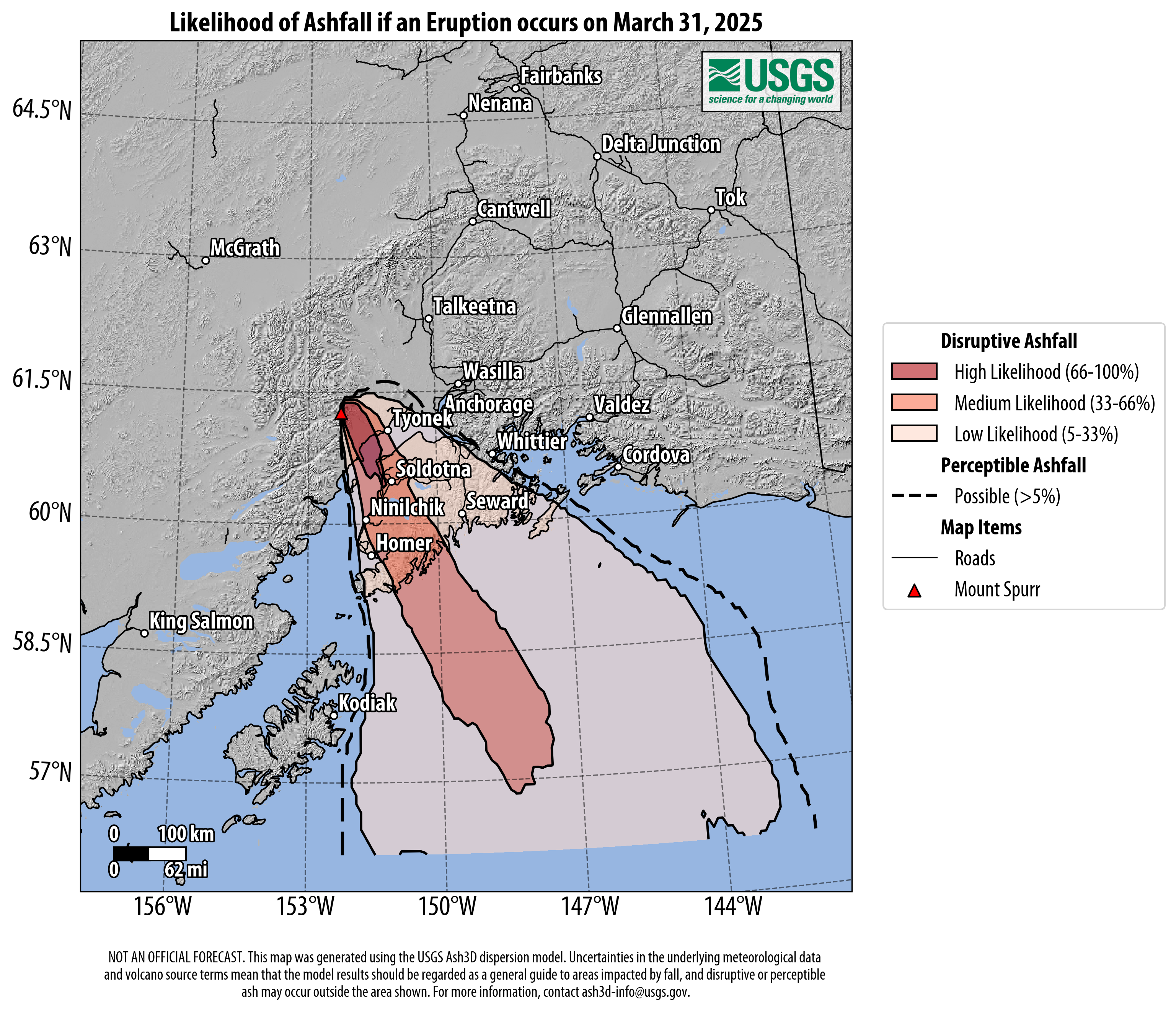Westdahl
Westdahl Eruption Timeline
| Red (Warning) | |
| Orange (Watch) | |
| Yellow (Advisory) | |
| Green (Normal) | |
| Uninstrumented | |
| Community | |
| Webcam | |
| Instrument | |
| Earthquake Magnitude | |
|
0
| |
| Earthquake Age | |
| Last 2 Hours | |
| Last 2 Days | |
| Last 1 Week | |
Distance from Anchorage: 78 mi (126 km)
Mount Spurr is a prominent member of the Cook Inlet volcanoes and is clearly visible from Anchorage on sunny days. The dramatic edifice is made up of several volcanic features. The ancestral Mount Spurr was a large volcano that catastrophically collapsed in early Holocene (post-glacial) time [1] , leaving behind a three-mile-wide caldera with a southeasterly facing breach and a spectacular debris-avalanche deposit in the Chakachatna River valley [1] . Since the collapse, two separate vents have built up their own edifices atop the remains of ancestral Spurr. The current Mount Spurr is a roughly conical lava dome complex [2] (summit elevation 11,070 ft/3,374 m) that rises several thousand feet above the caldera. Crater Peak, the second and more recently active vent, is a stratocone that has grown at the margin of the caldera, within the breach, and has a summit elevation of 7,575 ft (2,309 m) [1] . Mount Spurr and the surrounding caldera are deeply mantled by spectacular glaciers, with fifteen times the ice volume found on Mount Rainier [1] . Crater Peak has erupted explosively twice in the last century [1] and Mount Spurr exhibited a dramatic “ice cauldron” hydrothermal event from 2004 to 2006 [3] . Any future eruption of Mount Spurr or Crater Peak would likely be severely disruptive to Anchorage and the surrounding areas.
Mount Spurr is the secondmost northeasterly volcano in the Aleutian volcanic arc. It is found at the southernmost end of the Tordrillo Mountains, which are south of the Alaska Range and to the northwest of Cook Inlet [1] . It is bordered to the south by the Chakachatna River valley and to the southwest by the river’s headwaters, Chakachamna Lake, which is partially dammed by Barrier Glacier flowing out of the Tordrillo Mountains [1] . Mount Spurr is 78 miles (126 kilometers) northwest of Anchorage, and the closest community is Beluga, 37 mi (60 km) to the southeast. It is 56 mi (90 km) south of Mount Hayes and 58 mi (93 km) northeast of Redoubt Volcano.
Mount Spurr is notable for several major eruptions and periods of unrest that have occurred in the past 100 years. Crater Peak, the southern vent of Spurr volcano, erupted explosively in 1953 and 1992 [1] . Prior to the 1953 eruption, nearby Alaska residents had sometimes noted steam rising from the peak, which occurred more frequently in late spring 1953 [4] . On July 9, a single powerful explosion about an hour long created a 30,000 ft (10,000 m) high eruption plume [1] . An Air Force jet reported that it flew into the ash cloud for just a moment, but emerged with sandblasted paint and a frosted windscreen [5] , an early example of the dangers of aircraft encounters with volcanic ash. About a quarter inch (6 mm) of ash fell in Anchorage, 78 mi (126 km) away, shutting down Ted Stevens International Airport for two days, and ashfall was reported as far away as Valdez [1] . The eruption also caused pyroclastic flows that mixed with snow and ice and heavy local rainfall to create lahars that temporarily dammed the Chakachatna River [1] .
Seismic monitoring of Mount Spurr began in 1971. Starting in August 1991, increased seismicity was noted beneath Crater Peak. Between November 1991 and June 1992 seismicity increased further beneath the entire Spurr edifice. In mid-June 1992, seismicity increased still further [6] and the small crater lake within Crater Peak rapidly changed color and heated to boiling. The eruption began at 7:04 am June 27 following almost 19 hours of vigorous volcanic tremor and a shallow earthquake swarm under Crater Peak and was quickly reported by a passing Alaska Airlines pilot [7] . This time the eruption plume, which reached 47,500 ft (14,500 m), was blown to the north and 0.04-0.08 in (1-2 mm) of ash fell in Denali National Park. Once again, pyroclastic flows occurred and mixed with snow, ice, and water to form lahars that dammed the Chakachatna. Two more major explosions occurred at Crater Peak on August 18 and September 16-17. Winds carried ash from the August 18 eruption to the east, depositing as much as 0.12 in (3 mm) of ash in Anchorage that closed the Anchorage airport for 20 hours. Ash from the September 16-17 explosion moved in a more northeasterly direction and heavily impacted populated areas in the Matanuska and Susitna valleys [7] .
In 2004, unusual activity was noted at the summit of Mount Spurr, which until then had been thought to be much less likely to erupt than Crater Peak [1] . Several muddy debris flows appeared on the summit’s ice-covered flanks, and snow and ice at the summit melted and collapsed inward to create an “ice cauldron,” a heated crater lake that grew by melting the summit ice from below [2] . The ice cauldron continued to grow for over two years and featured dramatic boiling jets and fumaroles (one dubbed “Jumbo Jet”) before cooling in 2006 and becoming snow covered once again [3] . Addition of new seismic instruments allowed scientists to determine that magma was actually closer to the surface below Mount Spurr summit than below Crater Peak during this period [8] . Earthquake swarms have since occurred in 2012 and 2014-2017, though no eruption has yet followed [9] , [10] , [11] , [12] , [13] .
Several prehistoric eruptions from both vents of Mount Spurr are recorded in ash or tephra layers found in Alaska.
Mount Spurr (including Crater Peak) is listed as “very high threat” by the most recent edition of the USGS National Volcanic Threat Assessment [14] . This is because it has erupted frequently in recent history and has shown signs of unrest since its most recent eruption. It is near a large international airport with a high daily passenger volume and would likely disrupt air travel for some time in any future eruption and cut off air access to interior Alaska [14] . Because Mount Spurr is covered with an enormous volume of glacial ice, future eruptions are very likely to cause significant lahars, as happened in 1953 and 1992 [1] . If a lahar dammed the Chakachatna River, the river could back up to Chakachamna Lake and even “float” the ice dam there created by Barrier Glacier, which would likely lead to a very large flood that could reach Cook Inlet. As there are no permanent structures within the Chakachatna valley, this would luckily pose minor risk to people [1] .
A.H. Brooks named Mount Spurr in 1900, for Josiah Edward Spurr, a U.S. Geological Survey geologist who led an expedition in the area in 1898 (Orth, 1971).
Unrest continues at Mount Spurr volcano. Small volcanic earthquakes were detected beneath the volcano over the past day. No unusual activity was observed in partly cloudy satellite views over the past day. Web camera view were mostly obscured by cloudy conditions, but occasional clear views showed no unusual activity.
Although low-level unrest continues, no changes have been observed in the monitoring data to indicate that the volcano is moving closer to an eruption. Based on previous eruptions, changes from current activity in the earthquakes, ground deformation, summit lake conditions, and fumarolic activity would be expected if magma began to move closer to the surface. Therefore, if an eruption occurred, it would be preceded by additional signals allowing warning.
The volcano is monitored using local seismic, infrasound, web camera, and GNSS (GPS) stations along with regional infrasound, lightning networks, and satellite data.
| Eruption | |
| Questionable eruption | |
| Non-eruptive activity |










Mathematical models developed by the USGS forecast various aspects of how a volcanic ash plume will interact with wind—where, how high, and how fast ash particles will be transported in the atmosphere, as well as where ash will fall out and accumulate on the ground. AVO runs these models when a volcano is restless by assuming a reasonable hypothetical eruption, to provide a pre-eruptive forecast of areas likely to be affected. During an ongoing eruption, AVO will update the forecast with actual observations (eruption start time and duration, plume height) as they become available.
The Ash3d model was developed by the USGS to forecast how a volcanic ash plume will interact with wind and where ash will fall out and accumulate on the ground. AVO runs these models twice daily when a volcano is restless by assuming a reasonable hypothetical eruption altitude and duration. The map shows the model results of ashfall thickness for areas that are likely to be affected, if one were to occur. During an ongoing eruption, AVO will update the forecast with actual observations (eruption start time and duration, plume height) as they become available, and these plots will be automatically updated. The National Weather Service Anchorage Forecast Office will issue the official ashfall warning product and post them at weather.gov/afc
THESE PRODUCTS MAY NOT BE CURRENT.During an actual eruption, see National Weather Service forecasts of ashfall:https://weather.gov/afc.
This map shows the modeled estimate of the time it would take for ashfall to begin following an eruption. It corresponds to the ashfall thickness forecast map shown above. This map uses the start time of either the twice-daily hypothetical model runs (time shown in the legend) or the actual eruption start time (if one were to occur). In the case of an actual eruption, the National Weather Service Anchorage Forecast Office will issue the official ashfall warning product that includes the ashfall start time and post them at weather.gov/afc
THESE PRODUCTS MAY NOT BE CURRENT.During an actual eruption, see National Weather Service forecasts of ashfall:https://weather.gov/afc.
These maps show the areas that could experience ashfall if an explosive eruption of Mount Spurr were to occur. They show the area of “disruptive” ashfall where at least 100 g/m2 (0.3 oz/ft2) of ash could fall (in color), and a larger area where “perceptible” ashfall of 10 g/m2 (0.03 oz/ft2) could occur (as a dashed line).
Three ashfall likelihood maps are produced daily and provide ashfall forecasts for the current day, the next day, and two days later. These are intended to be used for situational awareness and planning purposes. Each map is based on 48 simulations using the USGS Ash3d model. The simulations vary the eruption start time and eruption cloud altitude using observations of three explosive events at Spurr in 1992 as guidance.
“High likelihood” areas are impacted in 66-100% of the simulations, “Medium Likelihood” areas are impacted in 33-66% of the simulations (25–50%); and “Low Likelihood” areas are impacted in 5-33% of the simulations.



The Ash3d model determines areas affected based on ashfall in units of mass per unit area (g/m2 or oz/ft2). Two ash deposits with the same mass per unit area but different densities will have different thickness: a denser ash deposit will be thinner than a less dense deposit of the same mass per unit area. We will not know the density until after an eruption starts and ashfall occurs, so a range of deposit thicknesses are given.
The “disruptive” ashfall maps show how likely it is for areas to receive at least 100 g/m2 (0.3 oz/ft2) of ash given the forecasted wind conditions. This threshold for potentially disruptive ashfall is based on case studies from around the world. A mass per unit area of 100 g/m2 corresponds to an ash deposit that is approximately 0.1 to 1 mm (0.004–0.04 inches) thick, depending on the deposit density and whether it has been compacted by rain or snow.
It is important to note that the threshold is a minimum value. The ash deposit from an actual eruption would likely be much greater closer to the volcano, and in populated areas. For example, the ash deposit in Anchorage from the August 1992 eruption of Mount Spurr was 10-20 times greater than the threshold used in the maps. Ashfall in Anchorage from the 1953 eruption was about twice that of 1992, and in both cases it was sufficient to block out the sun for several hours across Cook Inlet, turning day into “night”.
In general, the thicker the ashfall, the more problems it will cause on the ground, especially in populated areas. The 1992 ashfall closed the Anchorage airport for almost a day until it could be cleared, and presented air quality problems for months as the ash was resuspended by winds and vehicle traffic. A variety of other impacts are possible including abrasive damage to mechanical equipment, and disruptions to electrical service. Detailed information and photos of ashfall impacts and how to mitigate them is available through the Volcanic Ashfall Impacts Working Group.
The area of “perceptible” ashfall is shown on the maps using a dashed line and shows the area where 10 g/m2 (0.03 oz/ft2) of ashfall was in 5% of model runs. A mass per unit area of 10 g/m2 corresponds to an ash deposit that is at least 0.01 mm (0.0004 inches) thick, depending on the deposit density and whether it has been compacted by rain or snow. This amount of ash is noticeable to the naked eye and will be most apparent on surfaces that have a different color than the ash or are reflective and smooth, like snow or cars.